Gennaro Contaldo recipes to cook now we have left the EU
Italian food is among our favourite from the continent. Gennaro Contaldo – aka Jamie Oliver’s mentor – shows us how it’s done
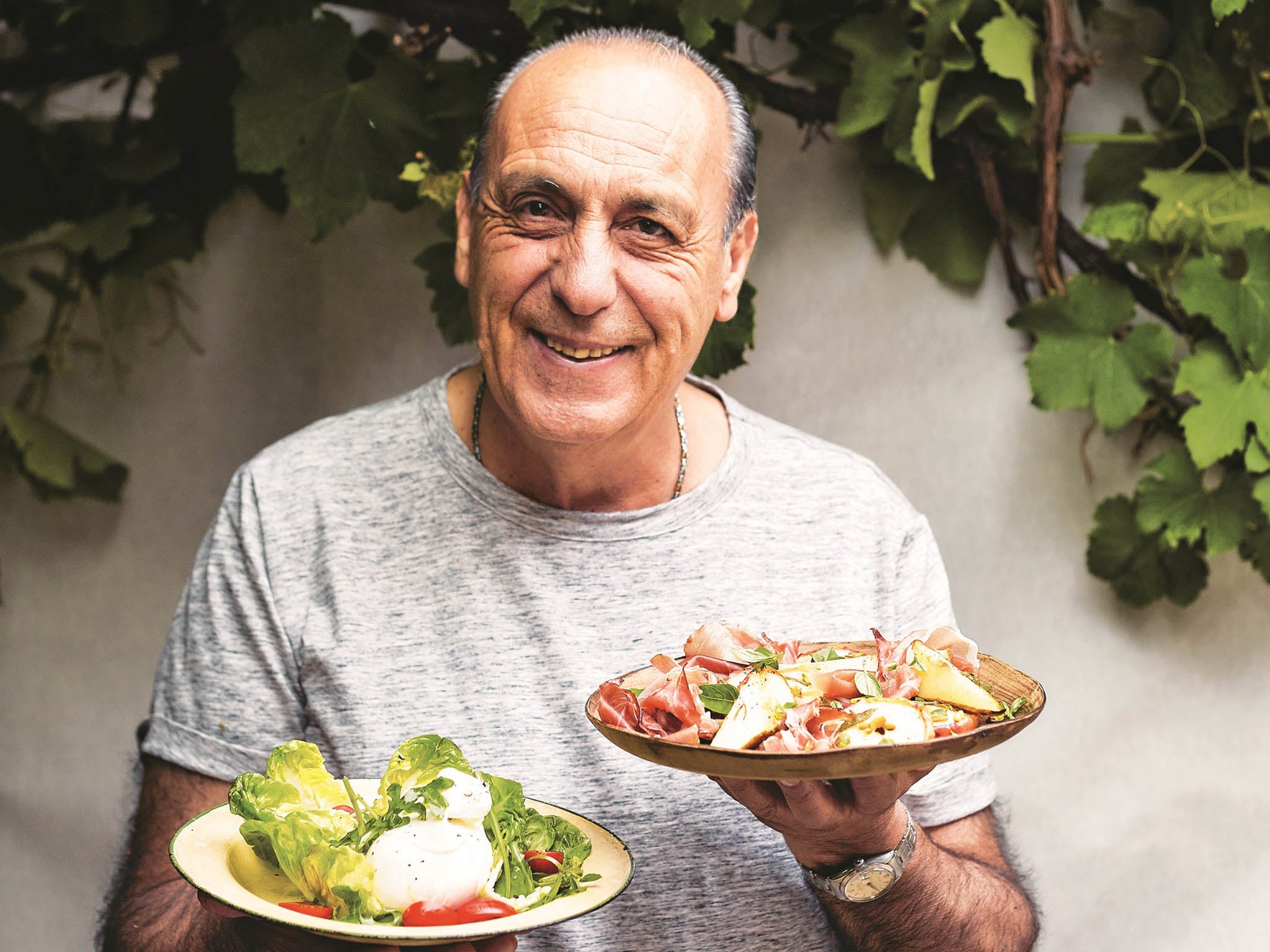
Ask anyone what their favourite cuisine is and Italian will rank highly time and time again. What’s a weekend without a Neapolitan style pizza, and what do we turn to for comfort? Pasta. That’s what.
An indulgent carbonara peppered with crispy pancetta, or a rich tomatoey dish of spaghetti bolognese and fresh basil will always please crowds.
Since the Seventies, Italian restaurants have thrived on our high streets, from little family-run holes in wall where even all the customers are Italian to the big chains from Zizzi to Pizza Express, with more and more Italian-grown produce cementing its place as a cupboard staple in our homes, too.
And it’s not stopped since; through the decades our love and obsession of the cuisine continues to expand and Italian food has since firmly conquered our tables. And not to mention our wine selection too, where most notably prosecco rivalled champagne as it’s more affordable cousin and quite literally flooded the UK market.
On TV Italian influence seeped in to shows, and chefs from Rick Stein to Jamie Oliver brought us even closer to the real deal with cooking shows filmed in Italy, using the freshest of ingredients from the sea, trees and producers, whipping up dishes that had us desperate to visit every corner of Italy.
Gennaro Contaldo – credited as the man who taught Jamie Oliver everything he knows about Italian food and has been his mentor for most of his career – grew up on the Amalfi Coast, spent his early years hunting and foraging with his father and grandfather and began working from the age of eight in a restaurant. He moved to the UK in 1969, and after working in Italian restaurants, opened his own, Passione, in 1999 which won Best Italian Restaurant 2005.
He worked closely with fellow Italian chef living in the UK, Antonio Carluccio. The pair had their own BBC2 series, Two Greedy Italians, he’s a frequent guest on Saturday Morning Kitchen, has his own YouTube channel and has written nine cookbooks. Here are some of his best recipes to cook now.
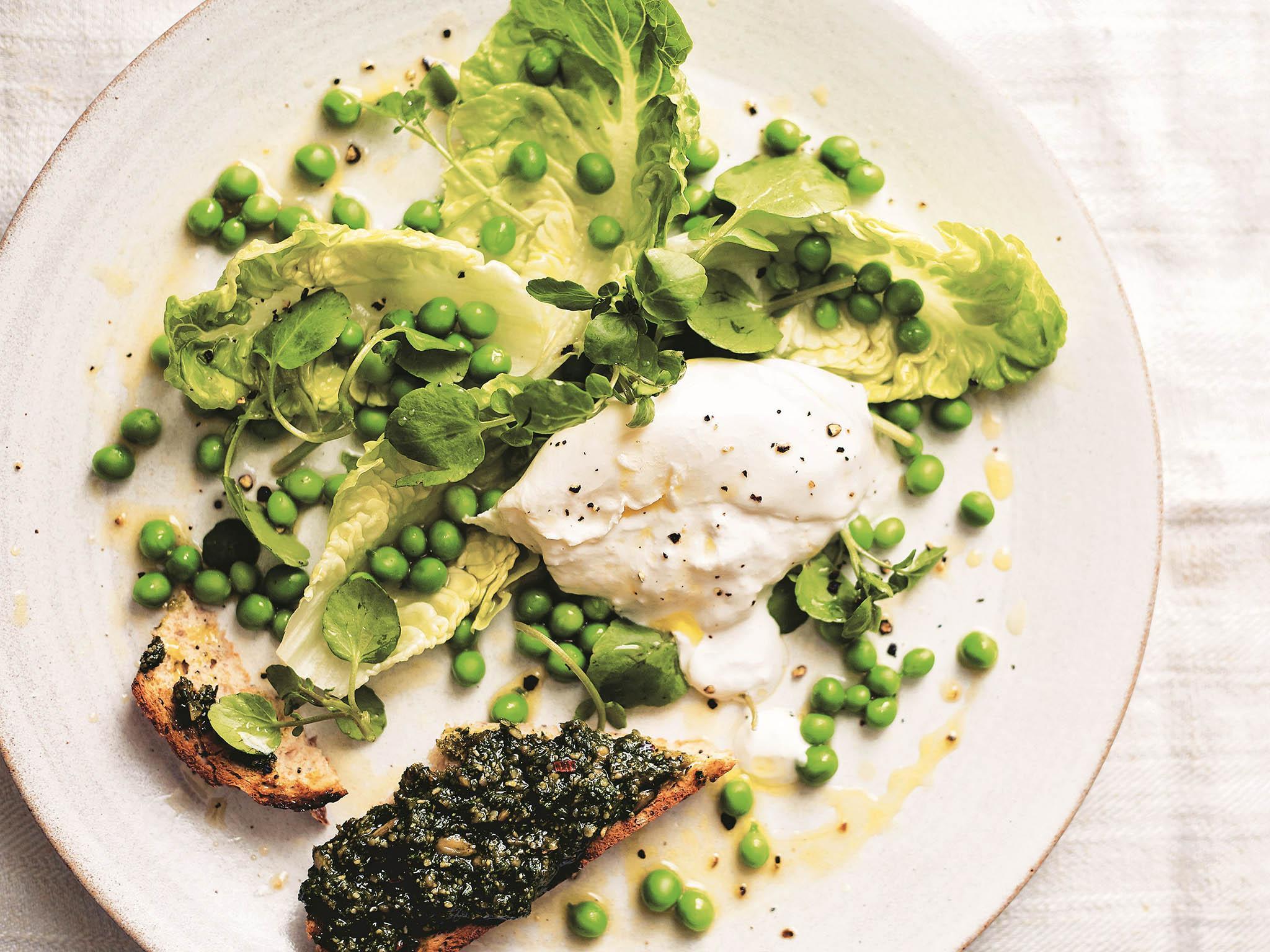
Insalata di piselli freschi e burrata – fresh pea and burrata salad, with sunflower seed crostini
This is a lovely salad to make during the spring, when fresh peas are available. For speed, you can buy ready-podded peas. Burrata is a fresh cheese from Puglia which looks like mozzarella but has a very creamy interior. Good Italian delis will stock it, but if you prefer, you can use bufala (buffalo) mozzarella instead. This dish makes a fantastic starter or can be enjoyed as a delicious, light lunch, accompanied by the crostini.
Cook: 15 minutes
Serves 4
175g fresh peas, podded weight
85g watercress
Leaves of 2 gem lettuce hearts
250g burrata, or buffalo mozzarella
For the crostini
50g sunflower seeds
A handful of fresh basil leaves
1tbsp extra virgin olive oil
A pinch of sea salt
A pinch of dried chilli (hot red pepper) flakes
4 slices of good-quality crusty, seeded wholemeal bread, toasted
For the dressing
2 tbsp extra-virgin olive oil
1 tbsp lemon juice
Sea salt and freshly ground black pepper
Bring a saucepan of water to the boil, add the peas and cook for about 2 minutes, until tender but not overcooked. Drain, rinse under cold running water and drain well.
Meanwhile, prepare the crostini. Place the sunflower seeds, basil leaves and olive oil in a blender or food processor and whiz until you obtain a smooth consistency. Combine with the salt and chilli flakes. Toast the bread and spread with the sunflower seed paste. Set aside.
Combine the dressing ingredients.
Arrange the watercress and gem lettuce leaves on a large serving plate, sprinkle over the cooked peas, and pour over half of the dressing. Gently break up the burrata or mozzarella and scatter over the greens. Drizzle with the remaining dressing and serve with the crostini on the side.

Carpaccio di zucchini – courgette carpaccio with pecorino, mint and pomegranate
Courgettes are so versatile and, when used raw, make a lovely starter or side salad. Make sure you use very fresh courgettes and slice them as thinly as you can. Ready-to-use pomegranate seeds are widely available in supermarkets all year round and not only look great, but also make a nutritious addition to this simple, delicious dish.
Prep: 15 minutes
Serves 4
2 courgettes
4 tbsp extra virgin olive oil
2 tbsp white wine vinegar
1 garlic clove, very finely chopped
1 tbsp finely chopped fresh mint, plus a few extra leaves for garnish
Sea salt, to taste
50g pomegranate seeds
30g pecorino, shaved
Using a vegetable peeler or a mandolin, slice thin slivers of courgette lengthways and set aside. Combine the olive oil, white wine vinegar, garlic and chopped mint, with some salt to taste, and whisk for a minute or so, until the mixture thickens slightly.
Dip the courgette slices in the dressing, then arrange on a serving plate. Pour over the remaining dressing, scatter over pomegranate seeds and Pecorino shavings, then garnish with the extra mint leaves and serve.
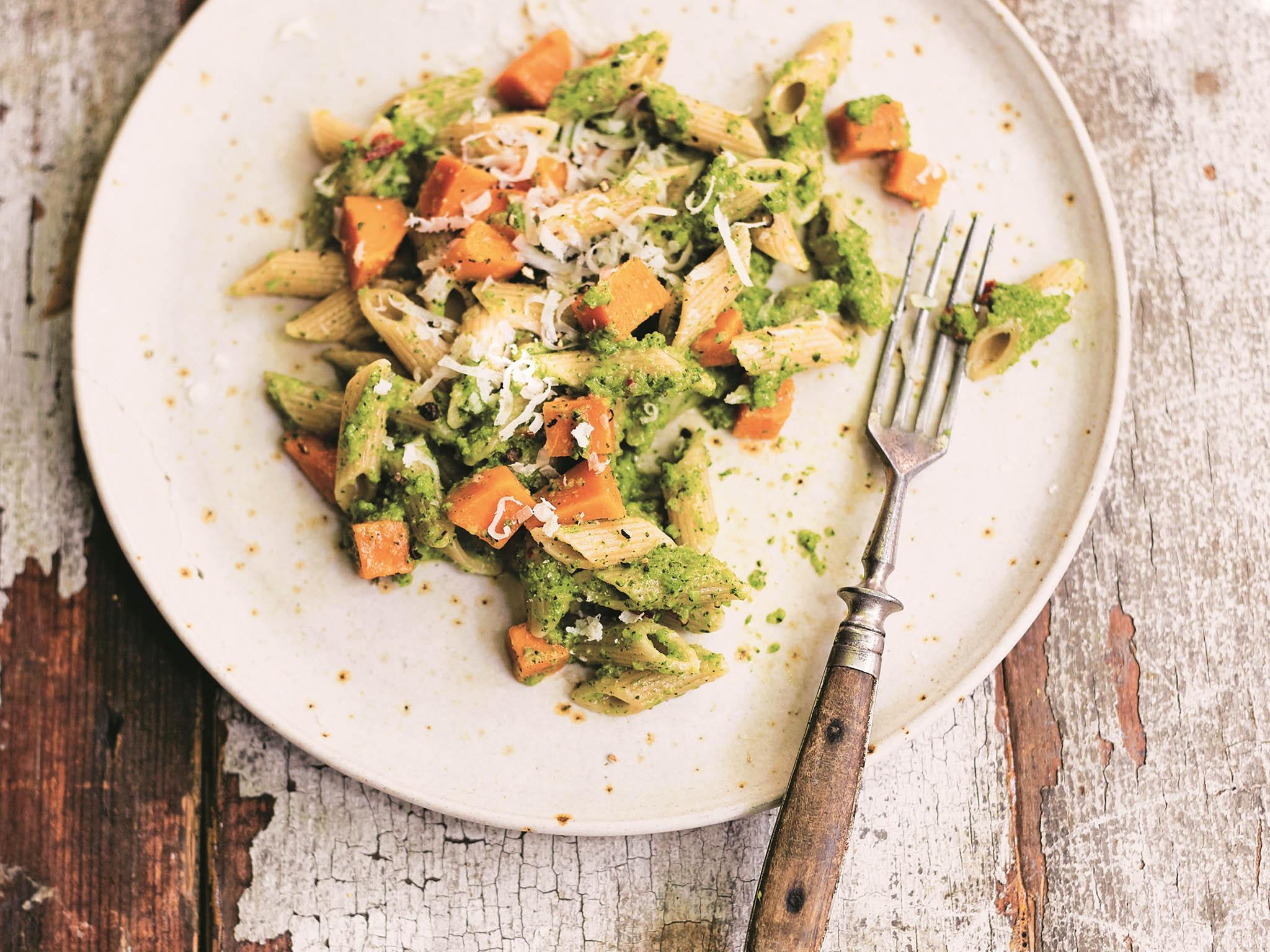
Penne integrali con broccoli e patata dolce – wholemeal penne with broccoli and sweet potato
Cooking time: 20 minutes (not including prep)
Serves 4
320g wholemeal penne
400g broccoli florets
250g sweet potato, cut into cubes
Sea salt, for the cooking water
3 tbsp extra virgin olive oil, plus an extra splash
2 garlic cloves, finely chopped
½ fresh red chilli, finely chopped
60g grated parmesan, plus extra for sprinkling, if desired
Pasta with broccoli is a common dish in Italy, where it is usually flavoured with garlic and chilli. In this recipe, the broccoli is mashed in a blender and served with small chunks of delicious sweet potato, adding extra nutrients and colour to the dish. It makes a healthy combination, which goes really well with wholemeal pasta. If you prefer, you can substitute the wholemeal penne with white-flour penne.
Bring a large saucepan of salted water to the boil and add the pasta, broccoli and sweet potato. Cook until the broccoli is tender, 4-5 minutes. Remove the broccoli with a slotted spoon and set aside to drain in a colander. Continue to cook the pasta and sweet potato, until the pasta is al dente, 8-10 minutes (check the instructions on your packet).
Meanwhile, heat the olive oil in a large frying pan (skillet) over a medium heat, add the garlic and chilli, and sweat for about 30 seconds. Add the drained broccoli and stir-fry for 1 minute or so. Remove from the heat and transfer the broccoli mixture to a food processor. Add a further splash of olive oil and the grated parmesan and blend until smooth. Return the mixture to the frying pan.
Drain the pasta and sweet potato, reserving some of the cooking water. Add to the broccoli mixture, mix well and heat through, together with a little of the reserved cooking water, if needed. Serve with an extra sprinkling of parmesan, if desired.
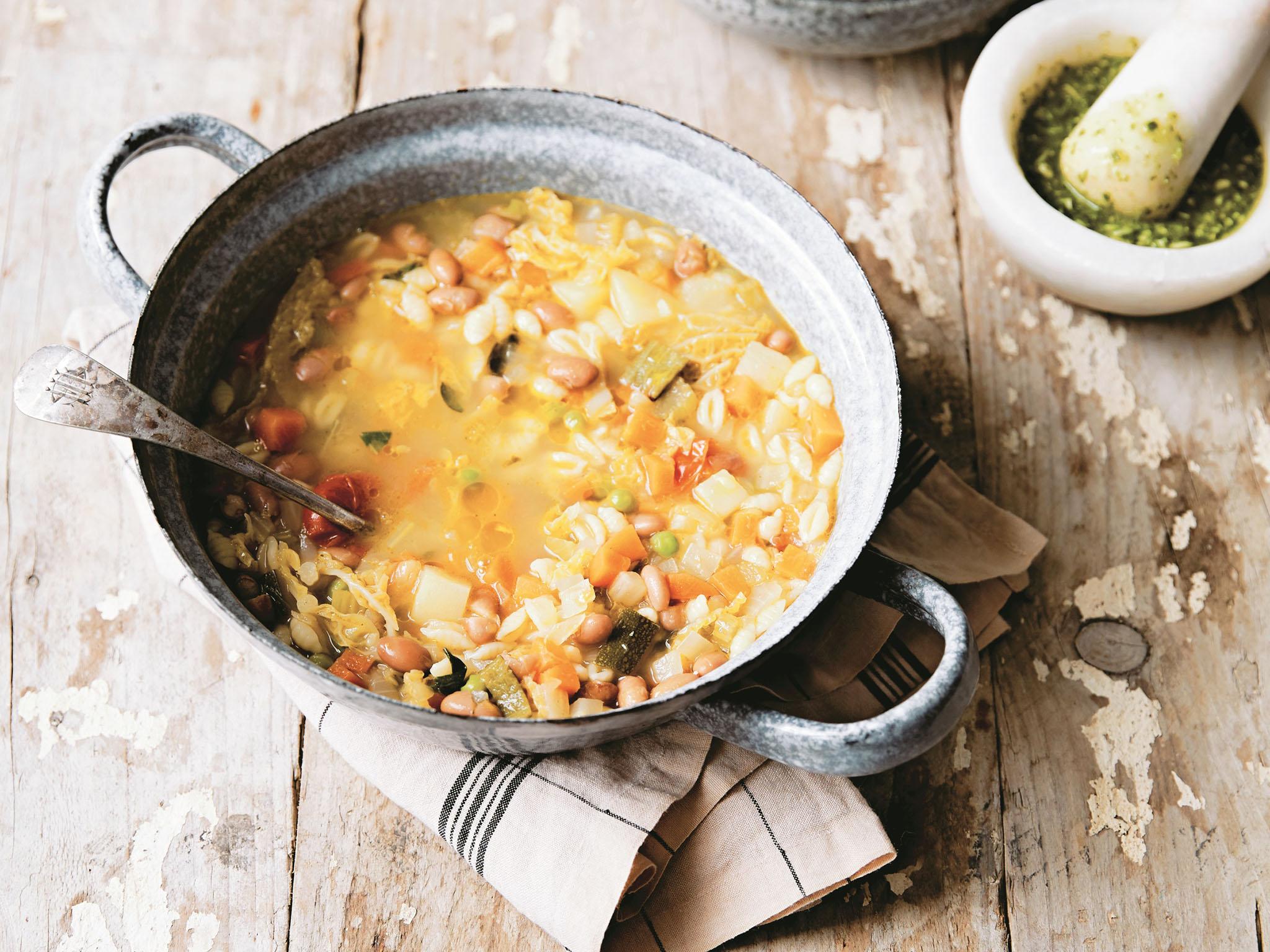
Minestrone veloce – quick minestrone soup
Packed full of nutritious veggies, this soup is basically vitamins in a bowl! Based on the classic Italian minestrone, I have included borlotti beans and pastina (small pasta shapes). If you prefer, you could omit the pastina. In fact, you could omit any vegetable you don’t like or don’t have and replace with others. Most of these vegetables can be bought pre-washed and chopped, saving you time. For added flavour, you could serve with a dollop of pesto sauce.
Cook: 35 minutes (not including veg prep)
Serves 4-6
4 tbsp extra virgin olive oil
1 large onion, finely chopped
2 celery stalks, finely chopped
2 carrots, finely chopped
1 small fennel bulb, finely chopped
1 courgette, cut into small chunks
1 large potato, peeled and cut into small chunks
280g savoy cabbage, shredded
6 cherry tomatoes
A handful of fresh basil leaves
1.5l vegetable stock (bouillon)
1 x 400g can of borlotti (cranberry) beans, drained
50g frozen peas
75g small pasta shells (pastina)
Sea salt and freshly ground black pepper
Grated parmesan, to serve
Pesto sauce, to serve (optional)
Heat the extra-virgin olive oil in a large heavy-based saucepan set over a medium-high heat. Add the onion and celery and sweat for a couple of minutes. Add the carrots, fennel, courgette, potato, cabbage, tomatoes and basil, and mix well. Pour in the stock, bring to the boil, then lower the heat and cook for 20 minutes. Add the borlotti beans, peas and pasta and continue to cook for about 6-8 minutes, until the pasta is cooked (check cooking times on the packet).
Remove from the heat, season with salt and pepper to taste, and serve with grated parmesan and a dollop of pesto, if desired.
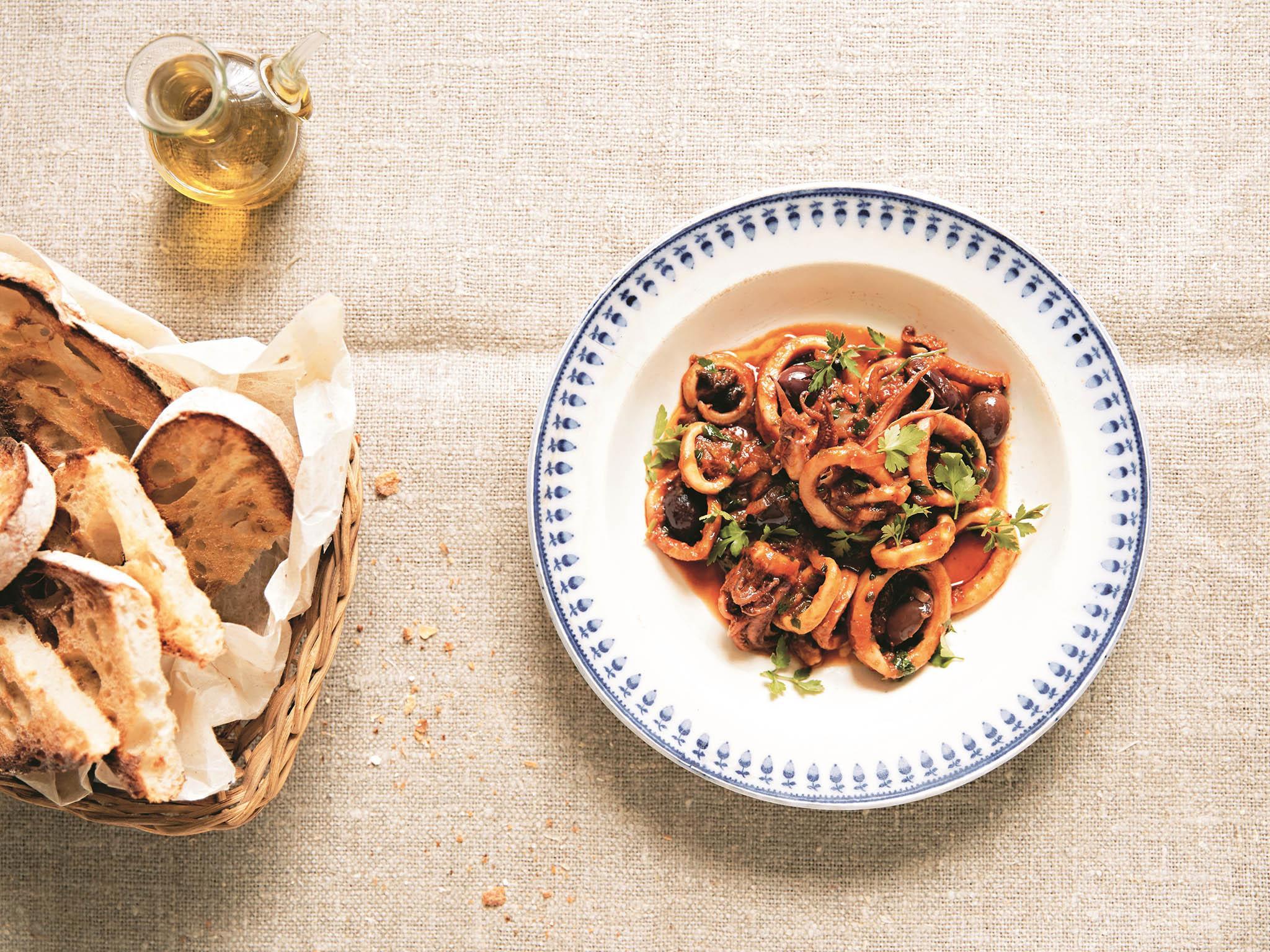
Calamari alle olive – squid with olives
A traditional southern Italian dish which is perfect to enjoy with a group of friends for a casual supper. Serve with lots of toasted country-style bread to mop up the tomato sauce.
Cooking time: 25 minutes
Serves 4-6
1kg squid
4 tbsp extra virgin olive oil
2 banana shallots, finely chopped
2 garlic cloves, finely chopped
A handful of fresh parsley, finely chopped
Sea salt and freshly ground black pepper
100ml white wine
240g tomato passata (strained tomatoes)
200g black olives
Toasted country-style bread, to serve
Wash the squid under cold running water, pat dry on paper towels and cut into rings.
Heat the olive oil in a large saucepan set over a medium heat. Add the shallots, garlic and parsley and sweat for a couple of minutes. Stir in the squid rings, season with a little salt and pepper, increase the heat to high and stir-fry for 1 minute.
Add the white wine and allow the alcohol to cook off. Add the tomato passata and olives, cover with a lid, reduce the heat to medium and cook for 15 minutes. Serve at once with the bread on the side.
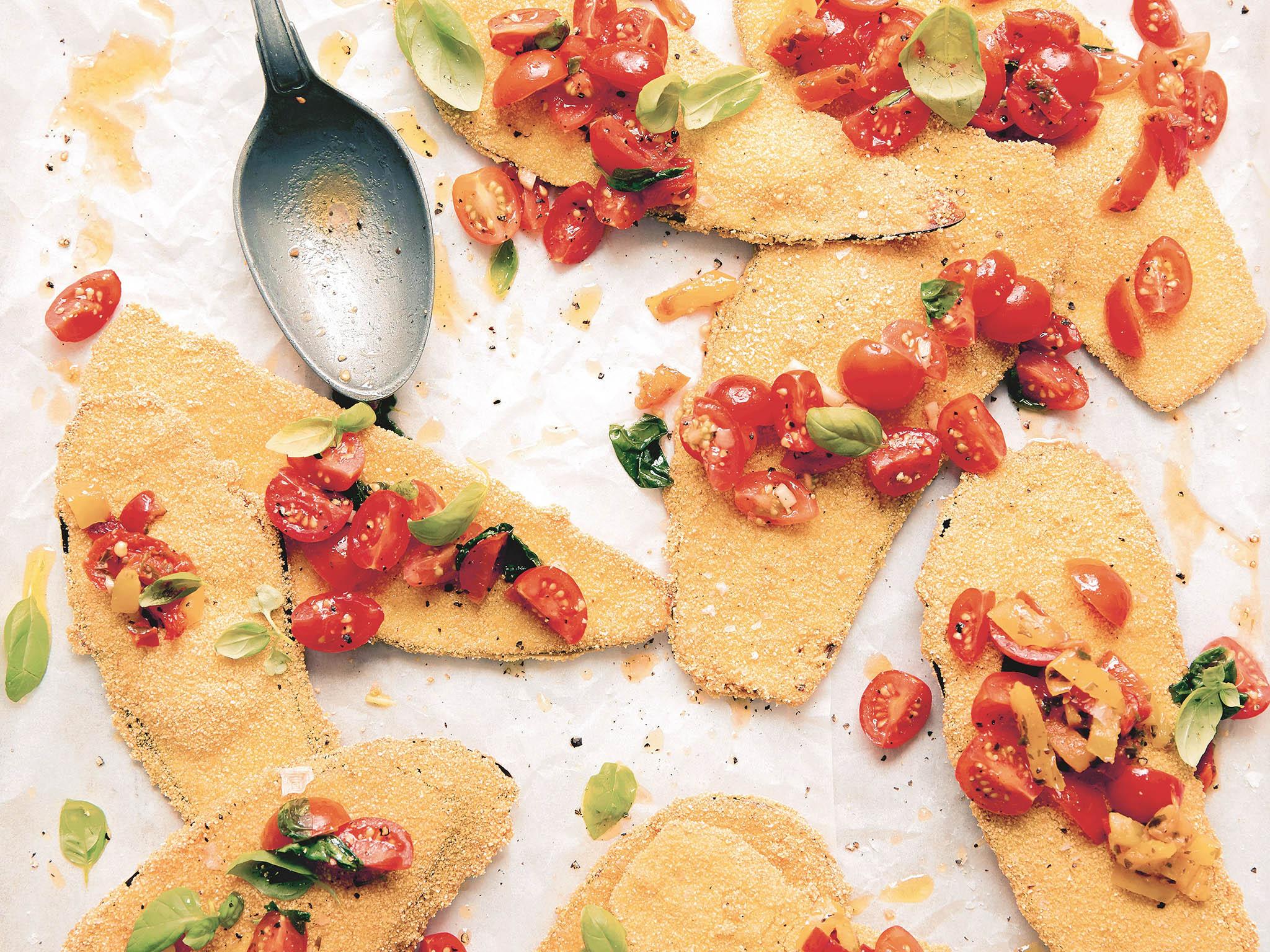
Aubergine slices with a parmesan and polenta crust
This idea was given to me by my wife Liz while we were making involtini di melanzane alla parmigiana together. It was her grandmother’s version of “vegetarian steak”, which she would make for the family during wartime when meat was scarce. It can be served as a snack, side dish or, indeed, a vegetarian main course. The aubergine slices are delicious topped with salsa alla crudaiola, a little garlic, basil, salt and pepper, or with preserved vegetables.
Serves 4-6
2 large eggs
25g parmesan cheese, freshly grated
1 large aubergine, peeled and cut lengthways into slices 5mm thick
Plain flour, seasoned with salt and pepper, for dusting
250g polenta
7 tbsp olive oil
Salt and freshly ground black pepper
Break the eggs into a bowl, season with salt and pepper, then add the parmesan and beat well. Dust the aubergine slices in seasoned flour, dip them into the egg mixture and then coat with the polenta.
Heat the olive oil in a large frying pan and, over a medium-high heat, fry the aubergine slices on both sides until golden brown. Remove, drain on kitchen paper and serve either hot or cold. When eaten hot, they are deliciously crunchy.
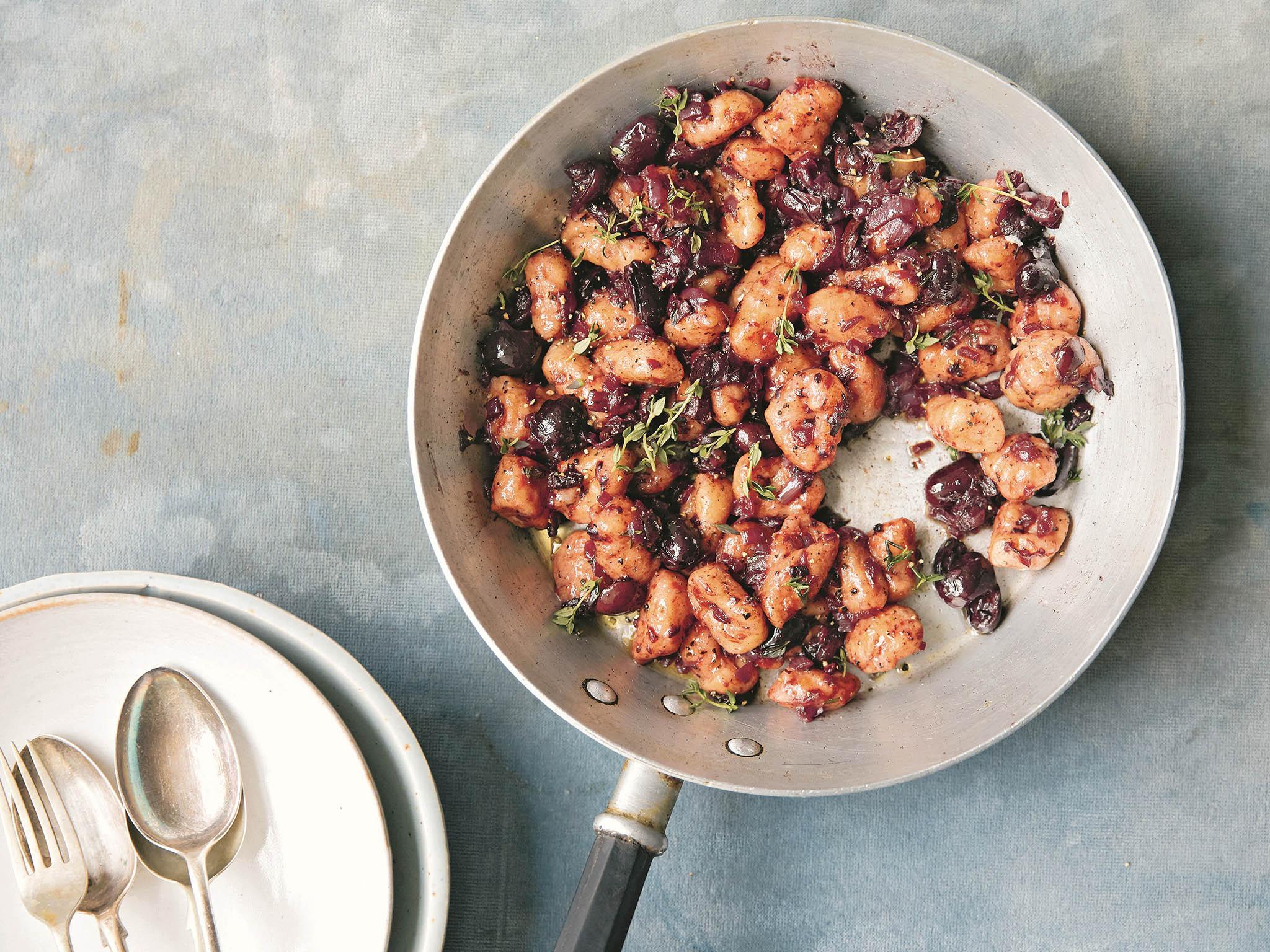
Sun-dried tomato gnocchi with black olive sauce
If you like sun-dried tomatoes, you will love this recipe. Very finely chopped sun-dried tomatoes are added to a basic potato gnocchi mixture, worked into a dough, then shaped and cooked in boiling water until they come up to the surface.
Serves 4
500g floury potatoes
150g plain flour
2 egg yolks
12 whole sun-dried tomatoes preserved in oil, drained and dried on kitchen paper
Salt and freshly ground black pepper
For the sauce
4 tbsp olive oil
1 small onion, finely chopped
2 garlic cloves, squashed but left whole
120g black olives, pitted and roughly chopped
A few sprigs of fresh thyme
120ml red wine
Place the unpeeled potatoes in a saucepan of lightly salted water, bring to the boil and simmer until tender. Once the potatoes are cooked, drain and leave to cool. Peel and mash the potatoes, preferably with a potato ricer to give a really smooth mash.
In a large bowl, combine the mashed potatoes with the flour, egg yolks, salt and pepper.
Chop the sun-dried tomatoes very finely, almost to a pulp – if necessary, once chopped, blitz in a blender or food processor. Add the tomatoes to the potato mixture and mix well to form a soft dough. Take large pieces of the dough and roll them into sausage shapes, then slice into 2cm squares. Roll each one over the back of the tines of a fork to mark it slightly and give a traditional gnocchi shape.
Bring a large saucepan of salted water to the boil. Meanwhile, make the sauce. Heat the olive oil in a large frying pan, add the onion and garlic and cook gently until the onion is softened. Add the olives, thyme and wine and simmer until the wine has evaporated.
Season with salt and pepper. Drop the gnocchi into the pan of boiling water and simmer until they rise back up to the top. As they float to the surface, lift them out of the water with a slotted spoon, drain well and add to the olive sauce. Mix well and serve immediately.
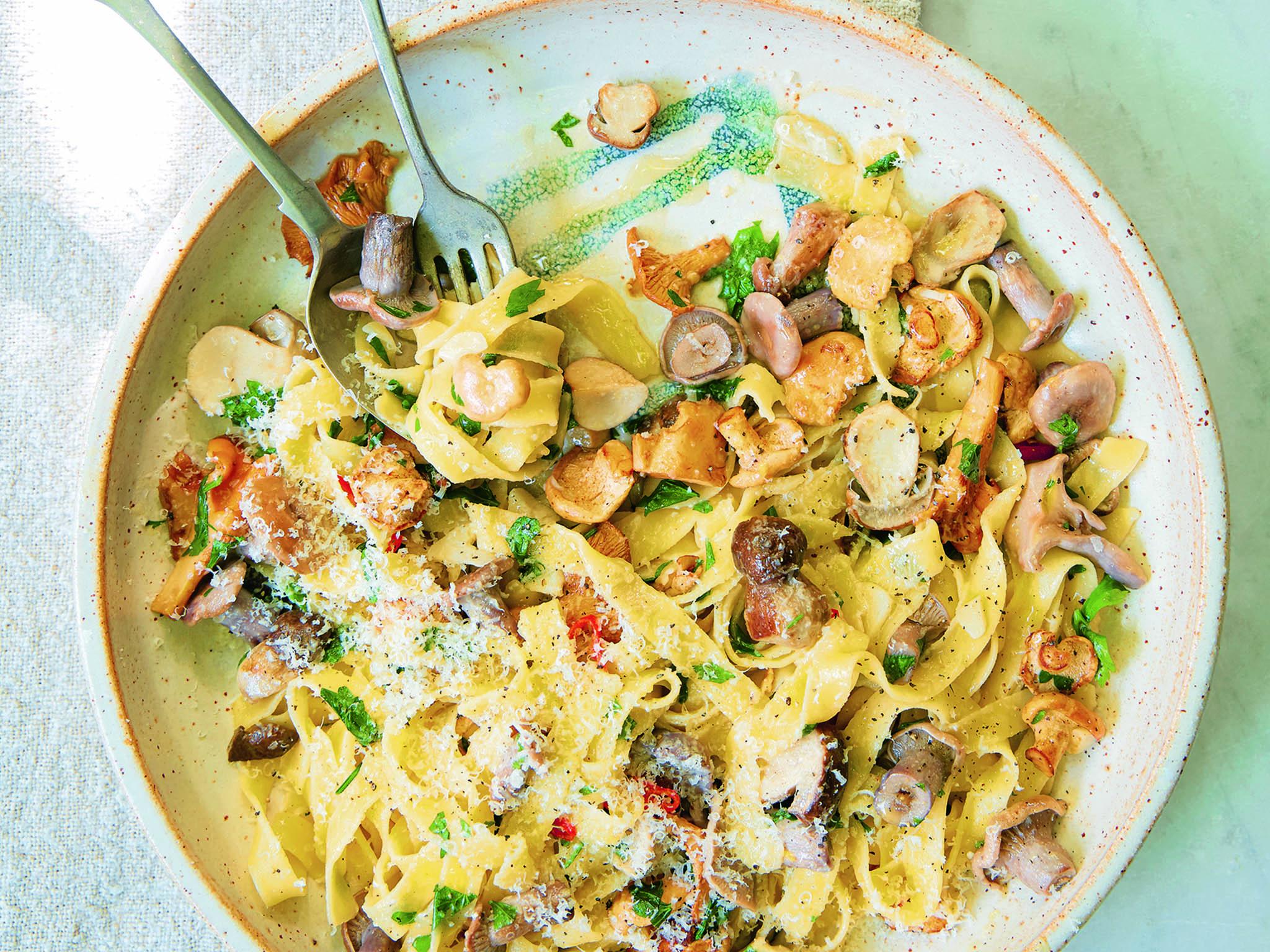
Tagliatelle con funghi misti – tagliatelle with mixed mushrooms
Fresh or dried tagliatelle are the perfect match for mixed mushrooms. Remember that you can use cultivated mushrooms, adding soaked dried porcini to give that “wild” taste.
Serves 4
225g fresh or dried tagliatelle
400g mixed wild mushrooms, such as porcini, chanterelles, hedgehog, wood blewits
6 tbsp olive oil
3 garlic cloves, finely chopped lengthways
1 small red chilli, roughly chopped
120ml vegetable stock
2 tbsp roughly chopped fresh parsley
Salt
Freshly grated Parmesan cheese, to serve (optional)
Clean the mushrooms with a cloth and brush – do not wash wild mushrooms, as the flavour disappears. Roughly chop any large mushrooms.
Place a large saucepan of lightly salted water on the heat and bring to the boil. Add the tagliatelle and cook until al dente (fresh pasta will take only about 1 minute; check the instructions on the packet for dried).
Heat the olive oil in a frying pan, add the garlic and chilli and sweat gently until softened – do not let them brown or burn. Turn up the heat a little, add the mushrooms and stir well for about 1 minute. Then add the stock, keep stirring, and cook for 2 minutes longer, until the liquid has evaporated slightly. Stir in the parsley and season to taste with salt.
Drain the pasta and add to the mushroom mixture. Mix well and serve immediately, sprinkled with some parmesan if desired.
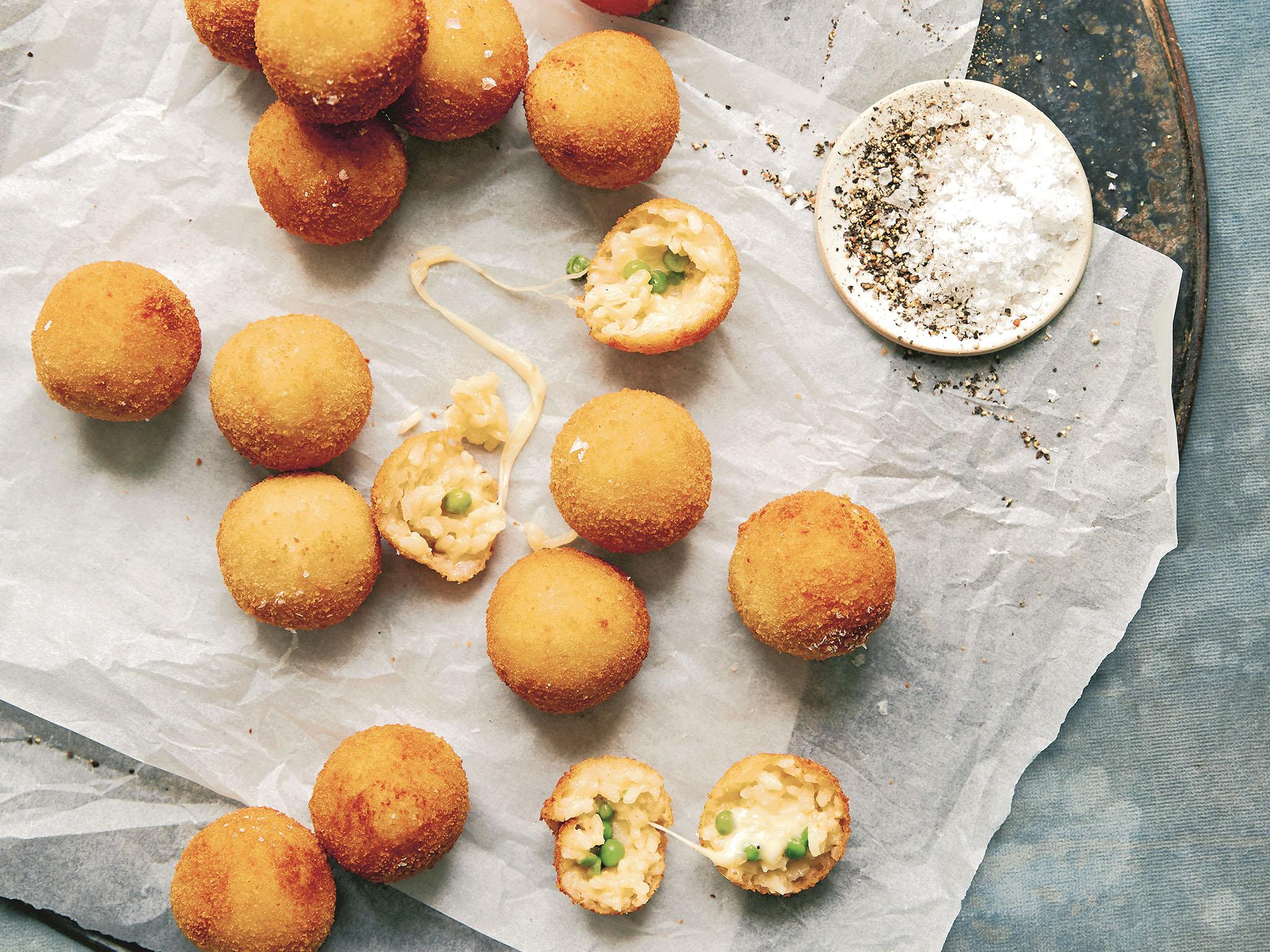
Arancini di riso – deep-fried stuffed rice balls
These typically Sicilian snacks are a great way of using up leftover risotto. Traditionally they are filled with different stuffings, such as minced meat or mixed vegetables, and sold as take-away snacks, but to make them simpler you could omit the filling. I have chosen a simple filling of peas and mozzarella. When deep-fried, the mozzarella melts and tastes wonderful as you bit into the arancino. I suggest you make lots, as once you start eating them you can’t stop!
Makes 25
Plain flour for dusting
2 eggs, beaten
Breadcrumbs for coating
Olive oil for deep-frying
For the risotto
1.5l pints vegetable stock
3 tbsp olive oil
1 onion, finely chopped
300g arborio or other Italian risotto rice
4 tbsp freshly grated Parmesan cheese
Salt and freshly ground black pepper
For the filling
1 tbsp olive oil
1 tbsp finely chopped onion
100g frozen peas
2 tbsp water
75g mozzarella cheese, diced
Make the risotto following the basic recipe (see below), omitting the butter (or use any leftover risotto you have). Spread the risotto evenly over a baking tray and leave to cool.
Meanwhile, make the filling. Heat the olive oil in a small pan, add the onion and sweat until soft. Then add the peas, water and some seasoning. Cover with a lid and cook for a few minutes, until the peas are tender. Leave to cool.
Take a little of the risotto and form it into a ball, roughly the same size as a golf ball. You will find it easier if you wet your hands with cold water. Make an indentation in each ball and place a few peas and a couple of cubes of mozzarella in it. Reshape the ball so the filling is in the centre and completely covered by the risotto. Dust with a little flour, then coat with beaten egg and finally coat in breadcrumbs.
Heat plenty of olive oil in a large, deep saucepan or in a deep-fat fryer. Add the risotto balls a few at a time and fry for 2-3 minutes, until golden brown. Drain on kitchen paper and serve hot or cold.

Basic risotto
The first rule when making risotto is to use the correct Italian rice, such as arborio, carnaroli or vialone nano, because they can absorb a huge amount of liquid without breaking up. Next, use good stock and the risotto will taste wonderful. Home-made stock is ideal but a good-quality cube or powder will suffice. Your stock can be any type, depending on the flavours you are adding. For a basic risotto, use vegetable or chicken stock. Cook the risotto at a gentle simmer and stir constantly to make sure it absorbs the liquid evenly and doesn’t stick to the pan. Add stock a little at a time, making sure that each batch has been absorbed by the rice before adding more. The stock must be hot, otherwise the risotto will stop cooking when it is added and the dish will be ruined, so keep it simmering in a separate pan. You may find you need a little more or less stock than the amount specified in the recipe, so always have a little extra ready. If you follow these few simple rules then there is no reason why you shouldn’t make successful risotto. Just like pasta, it can be a homely, comforting dish using vegetables, or a chic dinner-party affair with wild mushrooms, seafood or even truffles.
Serves 4
1.5l pints vegetable or chicken stock
3 tbsp olive oil
1 medium onion, finely chopped
375g arborio or other Italian risotto rice
50g butter
40g parmesan cheese, freshly grated
Salt and freshly ground black pepper
Put the stock in a saucepan and bring to a gentle simmer. Leave over a low heat. In a medium-sized, heavy-based saucepan, heat the olive oil and sweat the onion until soft. Add the rice and stir until each grain is coated with oil. You will notice the rice becoming shiny. At this stage, add a couple of ladles of the hot stock and cook, stirring all the time, until it has been absorbed. Repeat with more stock. Continue adding the stock in this way until the rice is cooked, which usually takes about 20 minutes. To check if it is done, taste the rice – it should be soft on the outside but al dente inside.
Remove from the heat, add the butter and parmesan and beat well with a wooden spoon to obtain a creamy consistency. In Italy, this procedure is known as mantecare. Taste and adjust the seasoning. Leave to rest for 1 minute, then serve.
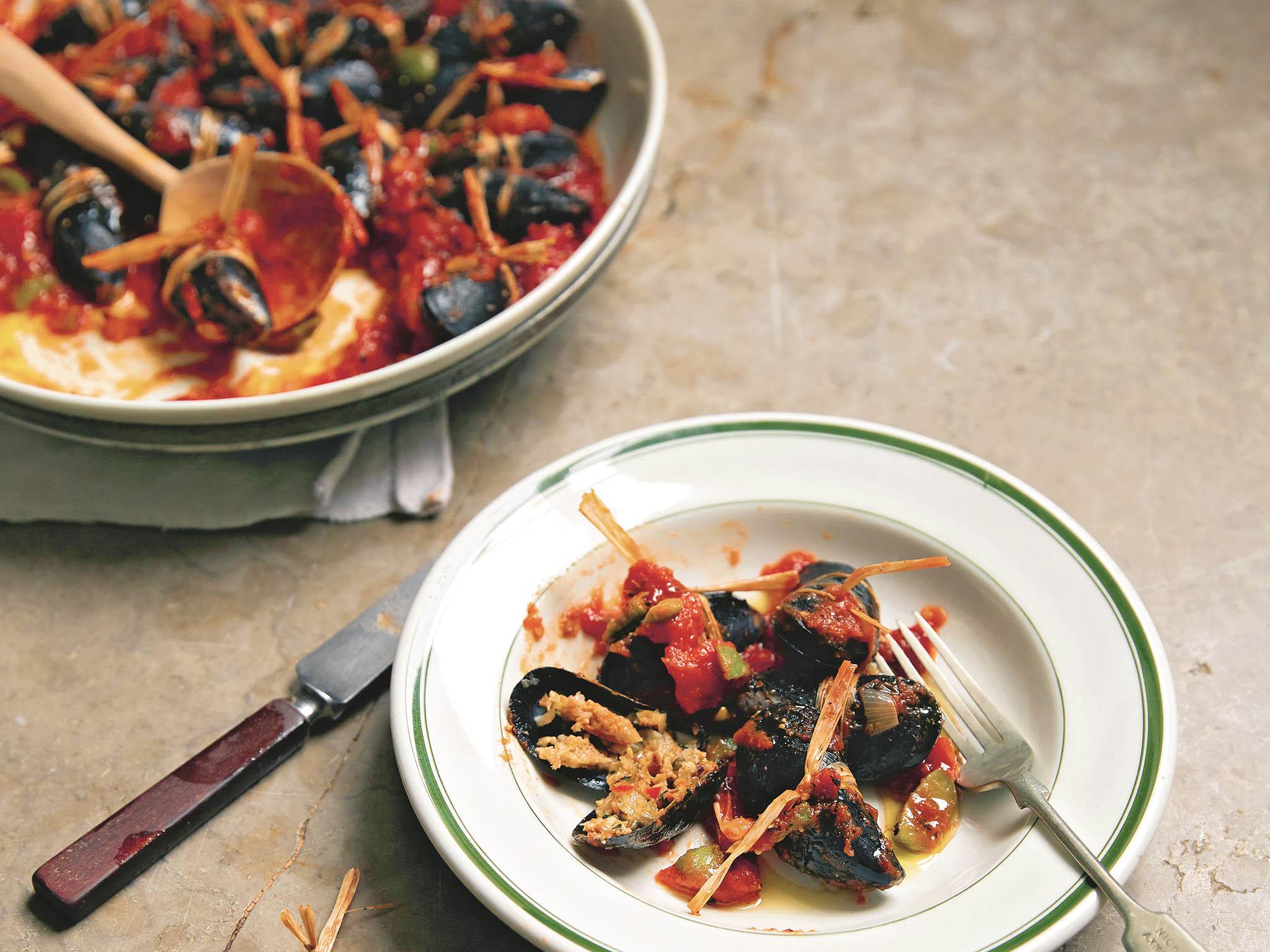
Stuffed mussels with tomato sauce
Because I lived by the sea, mussels were part of my life, and as a child I would pick bucketfuls of them during the cooler autumn months. When we had larger mussels, my father would often make this dish by removing the mussels from their shells, mixing them with stale bread, garlic and parsley and then stuffing the shells with this mixture. Using mussels in this way made an unusual, tasty dish and also meant they would go further to feed a large family. If you like mussels, try this dish for an informal supper with friends; it’s fun to eat, as you have to remove the raffia tied round each mussel.
Serves 4
12 large mussels
4 tbsp extra virgin olive oil
4 anchovy fillets
1 garlic clove, thinly sliced lengthways
½ small red chilli, finely chopped (optional)
20 capers
3 tbsp white wine
A handful of fresh parsley, finely chopped, plus a few sprigs to garnish
100g stale bread, cut into small cubes
For the sauce
2 tbsp extra virgin olive oil
½ small onion, very finely diced
½ tsp dried oregano
2 large green olives, pitted and sliced
400g tinned chopped tomatoes
Salt and freshly ground black pepper
Clean the mussels in plenty of cold water, scrubbing them well and pulling off the beards. Place in a pan, cover and steam for 2-3 minutes until the shells open. Remove from the heat and discard any mussels that are still closed. Remove the flesh from the shells and any liquid and place in a bowl (if necessary, open up the shells a little more, taking care to keep the shells intact). Keep the empty shells for later.
Heat the olive oil in a pan, add the anchovies and stir with a wooden spoon until they have almost dissolved into the oil. Add the garlic, chilli if using, and capers. Once the garlic turns golden, stir in the mussels, reserving their liquid for later. Heat the mussels through, then add the wine and simmer gently for 1 minute. Pour in the liquid from the mussels and stir in the parsley. Remove from the heat, mix in the bread cubes, then leave to cool. When the mixture has cooled, place it on a chopping board and chop quite finely with a sharp knife. Transfer to a bowl and mix well until you get a mushy consistency.
Dry the mussel shells and generously fill one half of each shell with the mussel mixture. Close the shell, removing any excess filling that escapes, and wrap some raffia around the middle of the shell, tying it round a few times until nice and tight, so the shell cannot open (you could use string, but I think raffia looks much nicer). Trim off any excess raffia and put the filled shells to one side.
To make the sauce, heat the olive oil in a large pan, add the onion and, as soon as it begins to fry, add the oregano, olives and tomatoes. Season with salt and pepper and bring to a gentle simmer. Reduce the heat and simmer for 5 minutes. Add the mussels to the sauce, cover the pan and cook gently for 20 minutes, turning the mussels over halfway through the cooking time. Stir from time to time and, if necessary, add some water to prevent the sauce becoming too dry. Put the filled mussel shells on individual plates, pour a little sauce over and garnish with a sprig of parsley. Serve immediately and remember to provide finger bowls for your guests.
‘Gennaro’s Passione: The Classic Italian Cookery Book’ by Gennaro Contaldo (Pavilion Books). Photography by Kim Lightbody
Join our commenting forum
Join thought-provoking conversations, follow other Independent readers and see their replies
Comments